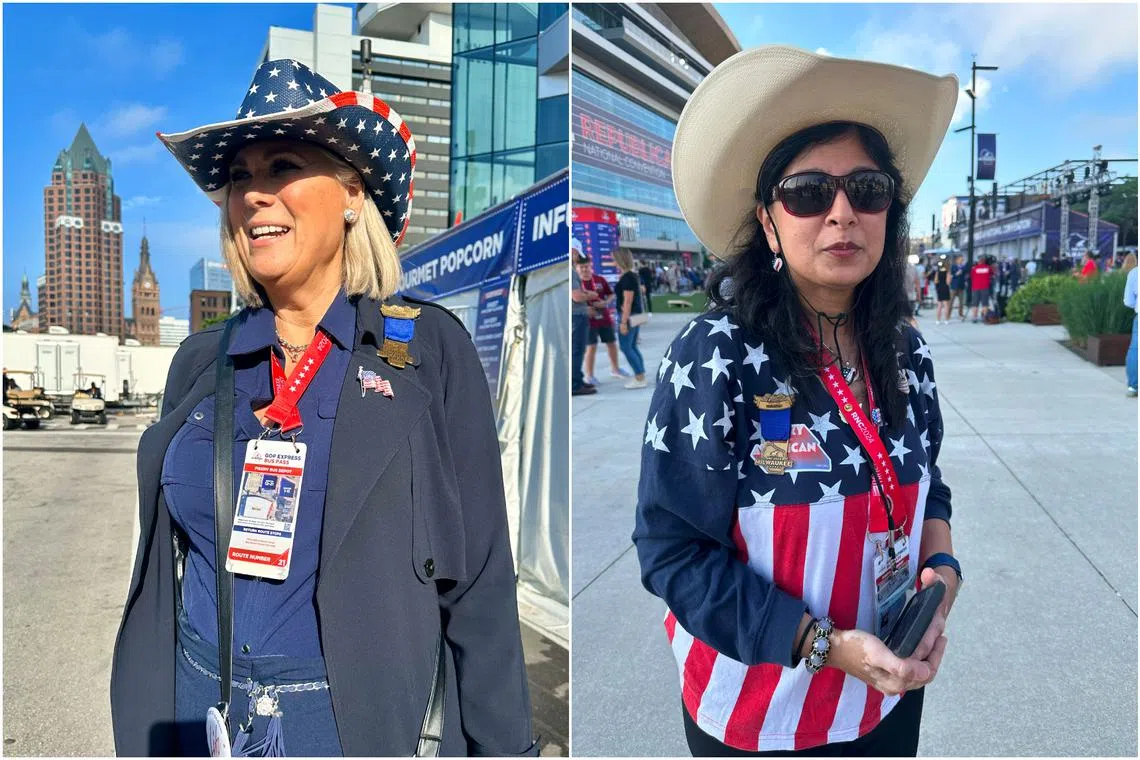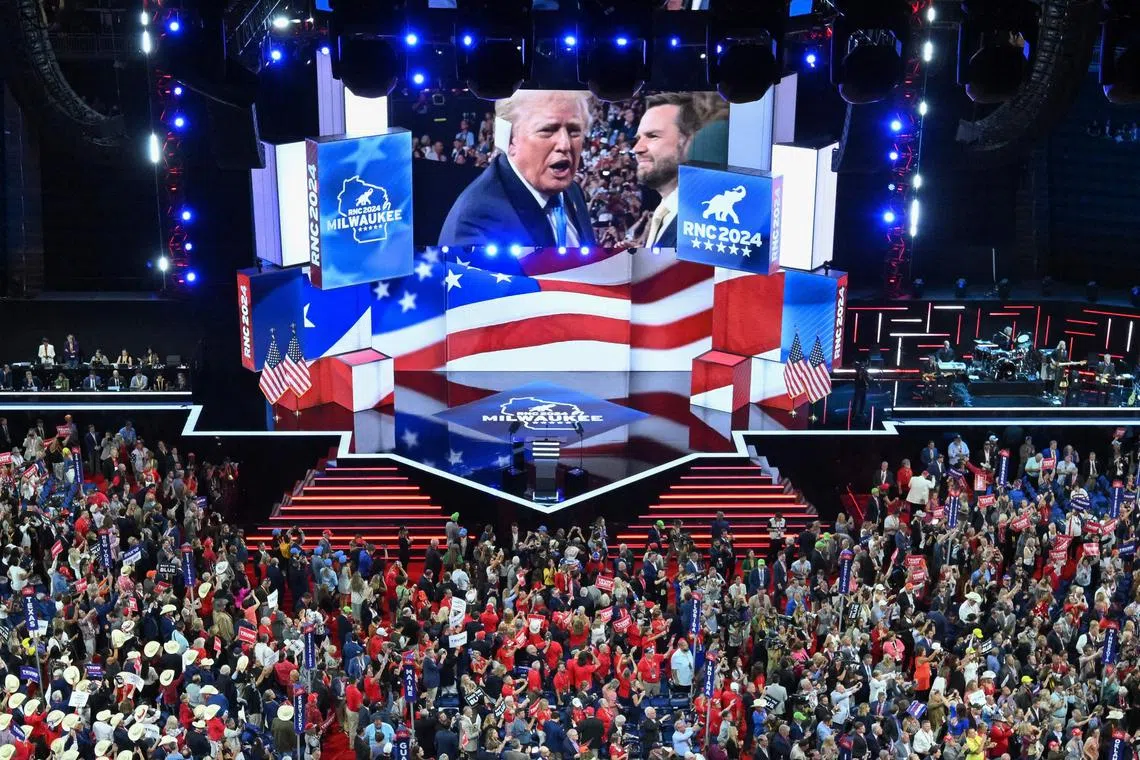In Harley-Davidson town, Trump revs up the Grand Old Party
Sign up now: Get ST's newsletters delivered to your inbox

(From left) Ms Stacey Schieffelin, a Republican Party delegate from Texas,and Dr Seema Nanda, an eye doctor and Republican delegate from Houston.
ST PHOTOS: BHAGYASHREE GAREKAR
Follow topic:
MILWAUKEE - A tightly choreographed show has been unfolding in this city, the home of Harley-Davidson.
Like that celebrated, muscular American motorcycle recognisable all over the world, the Republican Party is also a Wisconsin baby.
The party – almost 50 years older than the motorbike – was founded here to oppose the advance of slavery in the American West.
And just as the loud, heavyweight Harleys are turning electric in a bid to reverse falling sales, the Republican Party is trying to rejig its fortunes by reinventing itself for today’s voters.
On July 15, the first day of the ongoing four-day national convention of the party
That show of support for the 78-year-old who escaped an assassination bid
Less expected was the sight of a millennial, multiracial rapper with a tattooed head and a union leader – not typical supporters of what is often called the party of conservative white men – who took the stage to hail him.
The presence of rapper Amber Rose, who said she felt free to express herself in Trump’s party, was a signal to her 24 million followers on Instagram.
Mr Sean O’Brien, the president of the Teamsters, likewise suggested it was okay for union workers to forsake loyalty to President Joe Biden.
On the second day, nearly all the Republicans who had tried for months to prevent the former president from becoming the party nominee made speeches about Trump’s fitness for the job.
Former South Carolina governor Nikki Haley, whom Trump had derided as “birdbrain” and who in turn called him a “bully”, gave him a ringing endorsement
Delegates at the convention said they caught the whiff of change, and it smelled like victory.
A big tent party, they said, was critical to its success in the Nov 5 election.
“Trump is moving the needle on all demographics, all, and that’s what a big tent party is supposed to be,” said Mr Ben Ellison, a delegate from Iowa who had acted as caucus captain for Trump, giving speeches on his behalf.
“You have got to have diversity of thought, diversity of ideas, diversity of creation and innovation. That’s how parties get stronger,” he added.

Mr Ben Ellison, a Republican delegate from Iowa, acted as caucus captain for former US president Donald Trump, giving speeches on his behalf and trying to canvass votes for him in the party’s primary elections.
ST PHOTO: BHAGYASHREE GAREKAR
Ms Stacey Schieffelin, a party delegate from Texas and a senior adviser at the America First Policy Institute, said: “We’re seeing people come together who would never have thought about being in the Republican Party. It doesn’t matter where they’re from, we all want faith, family and freedom.”
Ms Elizabeth Gernert, a delegate from Tennessee, said she was not surprised that the young, the African-Americans and even Democrats were coming into the party fold.
“We are celebrating America here at this convention, not just Republicans. The platform announced here is inclusive of everyone. It says we will sweep you up and take you into prosperity.”
The change, they said, had begun with Trump who seemed “calmer, cooler” after the July 13 attempt on his life.
“He seemed a little more reserved, a little more cautious,” said Mr Ellison.
“But he is still just himself, which is why I’d rather have him than other politicians. They give more rhetoric, he gives more substance.
“People are paying more attention to who he is and how he thinks after the assassination attempt. But he has always been that person. So he has a broader audience to explain who he has always been,” the Iowan delegate added.
To Dr Seema Nanda, an eye doctor and delegate from Houston, a meaningful cue was the 39-year-old Ohio senator whom Trump chose as his running mate.
“He has got J.D. Vance on board, who’s not exactly like him. He’s a little more libertarian, which kind of says we’re bringing the party together.”
But the changes in the party rankled with at least one disgruntled delegate, who did not want to be named.
“This isn’t the moderate party I grew up in,” said the man, who indicated this was the 10th convention he was attending. “It feels like we are navigating choppy seas,” he added, saying the party had become too “Trump-centric”.
“You can love it or leave it.”

Republican presidential candidate Donald Trump as seen on a screen as he arrives with running mate J.D. Vance on the second day of the Republican National Convention in Milwaukee, Wisconsin, on July 16.
PHOTO: AFP
Disruption in the works
One of the most definite signs of change can be found in the party’s 2024 platform or manifesto released just ahead of the convention. The 16-page document, dedicated to the “Forgotten Men and Women of America”, says it aims to “return to common sense”.
Its most surprising element is the moderate stance on abortion. It is a calculated move away from supporting a national abortion ban – the traditional party stance for more than four decades – to mention opposition only to “late-term abortion”. Given the heightened voter sensitivity on this issue, that makes ample political sense.
Just as notably, the party recently disowned the conservative think-tank Heritage Foundation’s Project 2025, which was supposedly a blueprint for a Trump second term.
Some of its startling proposals involved a change in rules so that federal government employees would be more “loyal to the president”, and cutting funding for abortions.
The central challenge that Trump, the biggest disruptor in US politics in decades, appears to have taken on is to break the party mould.
The majority-white party, chiefly concerned with the preservation of the country’s founding principles, is actively grappling with how to make itself electable in a country as diverse as today’s America.
Hispanic and Asian voters, however, tilt more Democratic, while black voters remain overwhelmingly Democratic, according to a Pew Research report in 2024.
But, encouragingly for Trump, polling also suggests that black, Hispanic and younger voters are more likely to identify as Republican than they used to be, and more willing to vote for Trump than was the case in 2016 or 2020.
Ms Haley pushed that argument, as Trump looked on approvingly. “We must not only be a unified party, we must also expand our party,” she said.
“We are so much better when we are bigger. We are stronger when we welcome people into our party who have different backgrounds and experiences.
“And right now, we need to be strong to save America,” she added.
Just so the messaging was not lost, the party also put out a formal notification.
“We look forward to welcoming Americans of all backgrounds into our big tent party and behind the Trump-Vance ticket in the lead-up to election day,” said a statement from Republican National Committee chairman Michael Whatley and co-chair Lara Trump.
The data on diversity, however, is not exactly encouraging.
Among the Democrats, four of the six Democratic tickets since 2000 have included at least one woman or a non-white American. Or both, as in the case of the country’s first female Vice-President Kamala Harris, who is of black and Indian parentage.
The Republican Party, on the other hand, has not fielded any person of colour and only one woman, then Alaska Governor Sarah Palin as Mr John McCain’s running mate in the 2008 election.
In 2024, although there seems to be an attempt to reflect a wider spectrum of views and demographics in the party, the ticket is once again white and male.
More guns, not more regulations
The stickiest point is one that Republicans cannot even put on the table.
Many delegates approached for views refused to entertain any question on guns or said they saw no need to tinker with gun laws despite their candidate being the victim of an assassination attempt.
Trump himself has not said a word on the subject despite being nicked by a bullet.
In fact, he will appoint judges who oppose stricter control on guns, according to his senior adviser Chris LaCivita, who addressed a gun rights group on the sidelines of the convention on July 16.
In the meantime, it is a firm “no”, on stricter background checks or raising the minimum age to buy a gun, which ranges from 18 to 21, depending on the type of gun and where it is sold.
The Republicans are also opposed to a ban on assault-style rifles – the type used by the gunman in the July 13 assassination bid.
In his first term, Trump undid regulation that made it harder for people with mental illness to purchase guns.
Mr Vance, who owns a rifle, opposed a Democrat-led effort to ban “bump stocks”, which turn rifles into machine guns that can fire hundreds of bullets per minute.
He has also called for the abolishment of the Bureau of Alcohol, Tobacco, Firearms and Explosives, the federal watchdog that enforces gun laws.
The Republicans believe, with almost religious fervour, that their constitutional right to bear arms is sacred, and gun violence is the result of weapons falling into the wrong hands.


